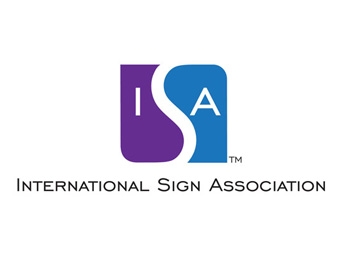Understanding—and even anticipating—the future can be a powerful business differentiator. But the sign industry has never had a reliable way to do so until the release of the ISA Sign Industry Market Monitor.
The ISA Market Monitor offers insight into four key areas of the sign and visual communications industry. Suppliers, distributors, and manufacturers in particular can use the ISA Market Monitor to predict orders and expansion opportunities based on anticipated growth.
The report is conducted quarterly by IHS and Vandiver Associates for the International Sign Association. It is based on an index value that shows whether growth will outpace or fall behind historical trends. That will help explain whether the market is growing larger than it typically does, or if it is slowing.
The ISA Market Monitor for the second quarter of 2014 shows stronger than average growth in all four areas: large-format printers, dynamic digital signage, electric signs, and wayfinding.
Electric Signs
With a .74 index in 2014, electric signs shows the most growth of the four key segments of the ISA Market Monitor. In 2015, it shows strong growth with a factor of .48.
Because of a close correlation between end-user expenditures on digital signage advertising and electric signage, growth in digital signage advertising signals a strong outlook for electric signs. IHS forecasted that digital signage revenue accounted for roughly 15 percent of all out-of-home advertising revenue for 2013.
Retail is one of the fastest growing sectors in digital signage advertising, primarily due to sales uplift, dwell time, ad recall, and branding techniques many companies are introducing through digital signage systems. Retail also is a key driver of the electric sign industry. It is expected to grow 3 percent in 2014 and 4 percent in 2015 and in 2016.
Large Format Printers
Large format printers will enjoy stronger than average growth in both 2014, with an index factor of .47, and 2015, with an index factor of .59. Growth in large format printers will come largely because of the expansion of the manufacturing sector, which is expected to grow 4 percent in 2014 and 5 percent in 2015. Manufacturing also is anticipated to grow by 5 percent in 2016.
Other industries that influence the growth of large format printers also expect modest growth. The segment of Coating, Engraving, Heat Treating, and Allied Activities should post growth of 3 percent in 2014, 4 percent in 2015, and 5 percent in 2016.
Forging and Stamping Output is expected to increase by 3 percent in 2014 and 4 percent in both 2015 and 2016. Hardware Manufacturing will grow by 1 percent in 2014 and 2 percent in both 2015 and 2016.
Dynamic Digital Signs
Dynamic digital signage also anticipates growth in 2014 and 2015 with factors of .21 and .48 respectively.
Hardware revenue comes largely from display mounts, which are forecast to increase an average of 2.9 percent between 2013 and 2017. Cable and other miscellaneous hardware is expected to increase an average of 2.4 percent over the same time period. Installation and project management revenue are expected to increase an average of 2.4 percent and 2.0 percent within that time period.
Private investment in software, which is expected to increase 6 percent in 2014, 7 percent in 2015, and 6 percent in 2016, is a key driver of growth in the dynamic digital sign market. Manufacturing, Coating & Engraving, and Forging and Stamping also influence growth in this market.
Wayfinding Signs
Wayfinding signage is naturally influenced by the addition of highways, streets and other construction. As it grows by 3 percent in 2014, it will provide a lift for wayfinding signage with a factor of .71 in 2014 and .45 in 2015. Wayfinding also is influenced by growth in out-of-home advertising, which is expected to increase 4 percent in 2014, 3 percent in 2015, and 4 percent in 2016. Professional services, another key driver, is expected to increase 2 percent each year in 2014 and in 2015.
While the first ISA Market Monitor provides a snapshot of the industry, future reports also will include historical trends, providing key data on how the industry is changing over time. Look for the next report near the end of the third quarter of 2014.











